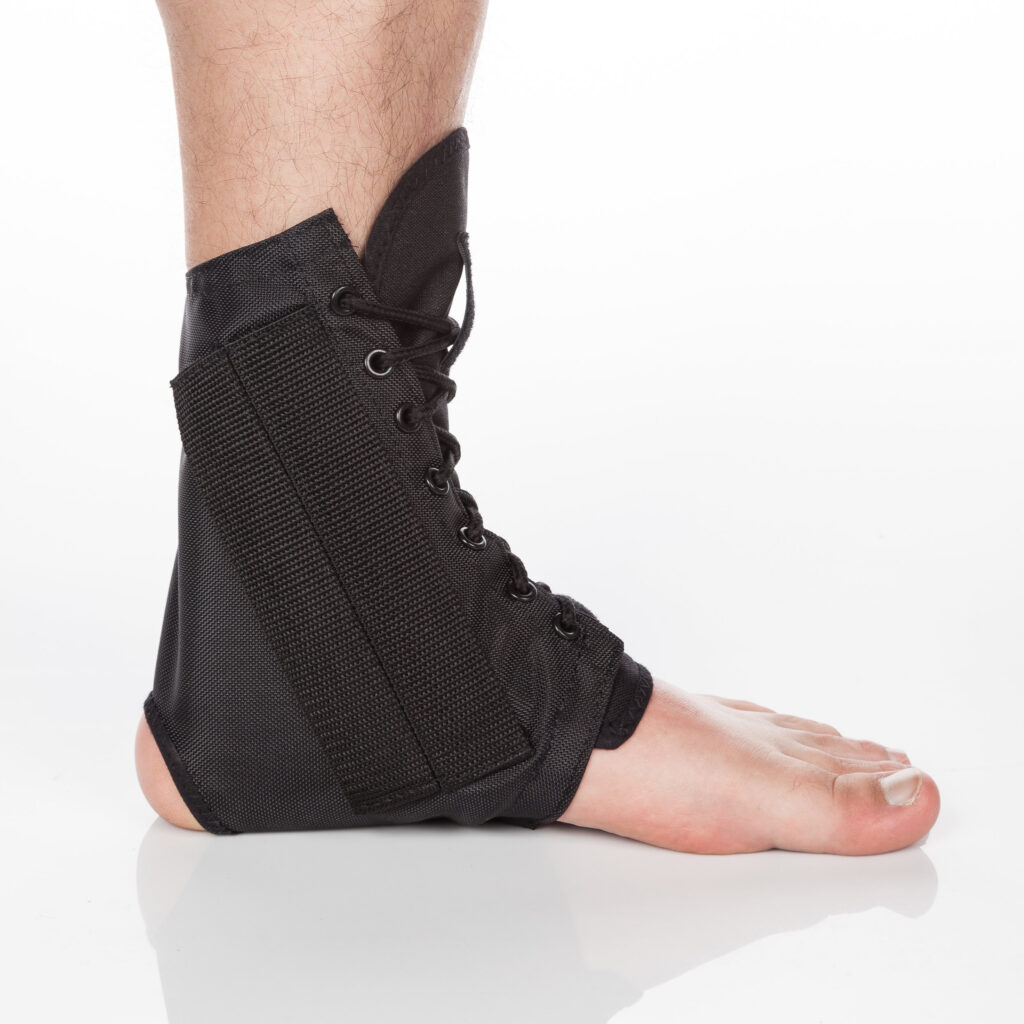Ankle sprains account for the most days lost to injury and ankle braces are often used to try and prevent them. I dug through the research to determine if they work and if so, are certain types more effective?
Ankle sprains are extremely common injuries(1–5), accounting for the most time lost in sports(6). Depending on the severity – ranging from a grade 1 to a grade 3 – an ankle sprain can keep you out for two weeks to up to over 6 months.
If not managed correctly, ankle sprains often occur repeatedly in close succession – “sprain clusters”(7) – and can lead to chronic ankle instability. In fact, up to 20-30% of individuals go on to suffer from chronic ankle instability(7–9).
Generally, a previous ankle sprain is the greatest risk factor for future ankle sprain(10). To combat that risk, external supports like ankle braces or ankle taping have been used and advertised as preventing future ankle sprains. However, do they actually work?
Yes, but it depends.
They’re only effective if you have a history of ankle sprains(6,11). If you’re proactively trying to prevent your first ankle sprain, ankle braces and taping won’t help.
However, if you do have a history of ankle sprains, the research shows that ankle bracing or ankle taping can reduce risk by upwards of seventy percent(6,11). Specifically, lace-up ankle braces have been found to be effective in reducing ankle sprains(12,13). However, in activities that require foot mobility in all directions, like soccer or dance, the rigidity and decreased range of motion resulting from lace-up braces isn’t a feasible option.
Further, research shows up to a five percent drop in running and jumping performance while wearing an ankle brace, depending on the specific brace or tape job(14). Five percent may not sound like a lot but in a game of inches or thin margins, that can be all the difference between winning or losing.
To sum up, here’s what we know:
· If you’ve sprained your ankle before, ankle bracing and taping reduces the risk of future ankle sprain
· Lace-up ankle braces are most effective at reducing future ankle sprains
· Wearing an ankle brace can result in up to a five percent drop in running and jumping performance
Personally, I only recommend ankle bracing and/or taping as a short-term solution – when you’re dealing with the immediate pain & instability of an ankle sprain or if you’re in the middle of a jam packed season with limited time for rehab.
In the long-term, it’s imperative to address the underlying root causes of ankle sprains. Fortunately, there is research-backed targeted training that help address these underlying root causes. I can personally speak to their effectiveness as I’ve gone from spraining my ankles every single time I played sports or ran trails to not having a singe ankle sprain in the last two years.
I’ll share those exercises with you in the next post. Stay tuned.
Sources
1. Doherty C, Delahunt E, Caulfield B, Hertel J, Ryan J, Bleakley C. The incidence and prevalence of ankle sprain injury: a systematic review and meta-analysis of prospective epidemiological studies. Sports Med. 2014;44(1):123-140. doi:10.1007/s40279-013-0102-5.
2. Vuurberg G, Hoorntje A, Wink LM, et al. Diagnosis, treatment and prevention of ankle sprains: update of an evidence-based clinical guideline. Br J Sports Med. 2018;52(15):956. doi:10.1136/bjsports-2017-098106.
3. Fong DT-P, Hong Y, Chan L-K, Yung PS-H, Chan K-M. A systematic review on ankle injury and ankle sprain in sports. Sports Med. 2007;37(1):73-94. doi:10.2165/00007256-200737010-00006.
4. Waterman BR, Owens BD, Davey S, Zacchilli MA, Belmont PJ. The epidemiology of ankle sprains in the United States. J Bone Joint Surg Am. 2010;92(13):2279-2284. doi:10.2106/JBJS.I.01537.
5. Roos KG, Kerr ZY, Mauntel TC, Djoko A, Dompier TP, Wikstrom EA. The Epidemiology of Lateral Ligament Complex Ankle Sprains in National Collegiate Athletic Association Sports. Am J Sports Med. 2017;45(1):201-209. doi:10.1177/0363546516660980.
6. Dizon JMR, Reyes JJB. A systematic review on the effectiveness of external ankle supports in the prevention of inversion ankle sprains among elite and recreational players. J Sci Med Sport. 2010;13(3):309-317. doi:10.1016/j.jsams.2009.05.002.
7. Al-Mohrej OA, Al-Kenani NS. Chronic ankle instability: Current perspectives. Avicenna J Med. 6(4):103-108. doi:10.4103/2231-0770.191446.
8. Chan KW, Ding BC, Mroczek KJ. Acute and chronic lateral ankle instability in the athlete. Bull NYU Hosp Jt Dis. 2011;69(1):17-26. http://www.ncbi.nlm.nih.gov/pubmed/21332435.
9. Guillo S, Bauer T, Lee JW, et al. Consensus in chronic ankle instability: aetiology, assessment, surgical indications and place for arthroscopy. Orthop Traumatol Surg Res. 2013;99(8 Suppl):S411-9. doi:10.1016/j.otsr.2013.10.009.
10. Beynnon BD, Murphy DF, Alosa DM. Predictive Factors for Lateral Ankle Sprains: A Literature Review. J Athl Train. 2002;37(4):376-380. http://www.ncbi.nlm.nih.gov/pubmed/12937558.
11. Verhagen EALM, Bay K. Optimising ankle sprain prevention: a critical review and practical appraisal of the literature. Br J Sports Med. 2010;44(15):1082-1088. doi:10.1136/bjsm.2010.076406.
12. McGuine TA, Hetzel S, Wilson J, Brooks A. The effect of lace-up ankle braces on injury rates in high school football players. Am J Sports Med. 2012;40(1):49-57. doi:10.1177/0363546511422332.
13. McGuine TA, Brooks A, Hetzel S. The effect of lace-up ankle braces on injury rates in high school basketball players. Am J Sports Med. 2011;39(9):1840-1848. doi:10.1177/0363546511406242.
14. Burks RT, Bean BG, Marcus R, Barker HB. Analysis of athletic performance with prophylactic ankle devices. Am J Sports Med. 19(2):104-106. doi:10.1177/036354659101900202.


